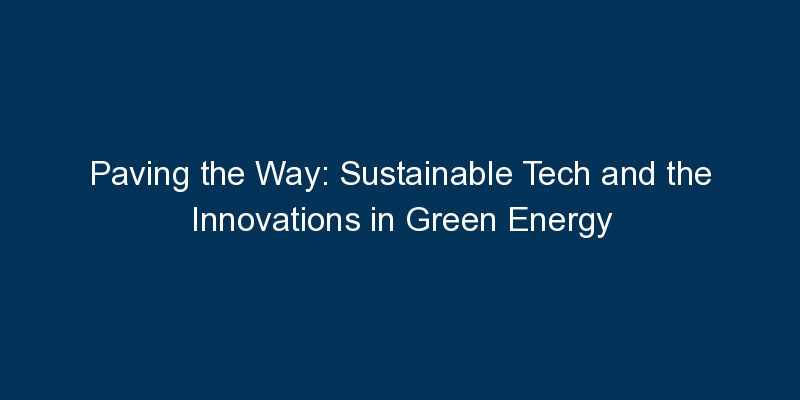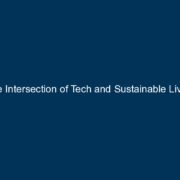Sustainable technology has become a cornerstone in the pursuit of a greener and more environmentally conscious future. In the realm of green energy, continuous innovations are reshaping the landscape of power generation, storage, and consumption. This blog delves into the cutting-edge innovations propelling sustainable tech forward, highlighting the strides in green energy that are fostering a more sustainable and eco-friendly world.
I. Harnessing the Sun: Solar Innovations
Solar Panels with Advanced Materials
The solar industry has witnessed a surge in innovation, with researchers exploring advanced materials to enhance the efficiency and durability of solar panels. Innovations like perovskite solar cells show promise in boosting conversion rates and making solar energy more accessible.
Solar Paint and Windows
In a bid to integrate solar technology seamlessly into our surroundings, researchers are developing solar paint and windows. These innovations allow surfaces to harness solar energy, transforming buildings into energy-generating structures without the need for traditional solar panels.
II. Power from the Wind: Advancements in Wind Energy
Next-Generation Wind Turbines
The evolution of wind energy includes the development of next-generation wind turbines. Vertical-axis turbines, biomimicry-inspired designs, and offshore floating turbines are among the innovations enhancing the efficiency and scalability of wind power.
Smart Wind Farms
Integrating smart technologies into wind farms optimizes energy production. Predictive analytics, machine learning, and IoT-enabled sensors enable wind farms to anticipate changes in wind patterns, adjust turbine angles, and maximize energy output.
III. Tapping into the Earth: Geothermal Innovations
Enhanced Geothermal Systems (EGS)
EGS technology aims to unlock the vast potential of geothermal energy in regions without naturally occurring geothermal reservoirs. By creating artificial reservoirs through hydraulic stimulation, EGS expands the reach of geothermal power generation.
Binary Cycle Power Plants
Binary cycle power plants harness lower-temperature geothermal resources by utilizing a secondary fluid with a lower boiling point than water. This innovation broadens the geographic scope for geothermal energy utilization.
IV. Powering Up with Water: Hydropower Advancements
In-Stream Hydrokinetic Energy Systems
Traditional hydropower often involves large dams, but in-stream hydrokinetic energy systems operate in flowing water, capturing kinetic energy without the need for extensive infrastructure. These systems are more environmentally friendly and suitable for diverse water bodies.
Pumped Storage Hydropower
Advancements in energy storage have elevated pumped storage hydropower. This technology involves pumping water to a higher reservoir during periods of excess energy and releasing it to generate electricity during high-demand periods, serving as an effective energy storage solution.
V. Energy Storage Revolution: Batteries and Beyond
Lithium-Sulfur Batteries
In the realm of energy storage, lithium-sulfur batteries are emerging as a promising alternative to traditional lithium-ion batteries. With a higher energy density, these batteries hold the potential to revolutionize the efficiency of energy storage systems.
Flow Battery Technology
Flow batteries, particularly those using vanadium redox chemistry, offer advantages in scalability and longer cycle life. This innovation addresses challenges associated with intermittent renewable energy sources by providing reliable and flexible energy storage solutions.
VI. The Role of Artificial Intelligence: Optimizing Sustainable Tech
Smart Grids
Artificial Intelligence (AI) plays a pivotal role in optimizing energy distribution through smart grids. AI algorithms analyze real-time data to predict energy demand, manage distribution, and enhance the overall efficiency of power networks.
Energy-Efficient Buildings
In sustainable architecture, AI contributes to the design and operation of energy-efficient buildings. Smart building systems leverage AI to regulate lighting, heating, and cooling based on occupancy patterns and environmental conditions, minimizing energy consumption.
Conclusion
The realm of sustainable tech and green energy is witnessing an era of unprecedented innovation. From harnessing the power of the sun and wind to tapping into the Earth’s geothermal resources, advancements in renewable energy are shaping a cleaner and more sustainable future. Energy storage solutions, driven by breakthroughs in battery technology, coupled with the optimization provided by artificial intelligence, are revolutionizing the efficiency and reliability of sustainable tech. As we navigate this landscape of innovation, the potential to create a more eco-friendly world powered by sustainable technology becomes increasingly tangible. The journey towards a greener future is not just a technological evolution; it is a collective commitment to shaping a world where innovation and sustainability go hand in hand.



















Comments